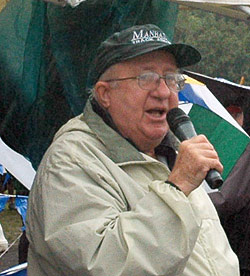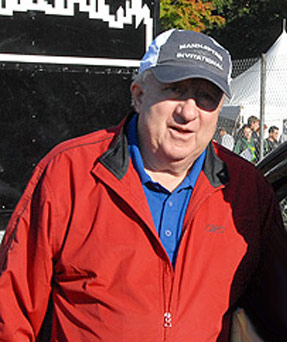 |
 |
 |
|
|
 |
 |
 |



What he’s Done:
For 39 years, from 1964-2003, he coached track and field and cross country at Bishop Loughlin High School in Brooklyn, New York. He coached three national championship boy’s relay teams: the distance medley in 1975, the distance medley in 1981, and the 4x800 in 1981. In 1973, Bowes founded the Manhattan College High School Cross Country Invitational, which is now the largest cross country competition in the United States and is still under his direction.
 On coaching through the years: I found coaching to be a learning process as I went along. I was in that in-between era in high school and college—distance runners and middle-distance runners didn’t train what I would have to call really hard. I realized when I started coaching and people started doing greater mileage at that time, that I was going to have to have to incorporate different things that I thought were right. I incorporated fartlek training, which really wasn’t being used in the high schools in New York City. I would lead them through a lot of the workouts. We have a 200-meter track in the back of the school and I might take them on an 80-lap run—10 miles. Pick it up, slow it up, pick it up, slow it up. I would always make sure we would pick it up when they were still tired from the previous pick up. On coaching through the years: I found coaching to be a learning process as I went along. I was in that in-between era in high school and college—distance runners and middle-distance runners didn’t train what I would have to call really hard. I realized when I started coaching and people started doing greater mileage at that time, that I was going to have to have to incorporate different things that I thought were right. I incorporated fartlek training, which really wasn’t being used in the high schools in New York City. I would lead them through a lot of the workouts. We have a 200-meter track in the back of the school and I might take them on an 80-lap run—10 miles. Pick it up, slow it up, pick it up, slow it up. I would always make sure we would pick it up when they were still tired from the previous pick up.
As training evolved, I realized that I’m going to continue the hard training, but that I also have to give them easy days. I’d begin training with the team around August 1st or late July. I felt that training for an 11-month period of time was necessary to be successful. I always believed in one month off at the high school level. I would insist they take the month of June or the first two weeks of July off.
Everybody would have to run cross country, even the sprinters. I felt that was very important, and we were very successful with the sprinters running cross country. They hated it, but they realized that it was important to prevent injuries. And, even the 400 runners, because they were in such great shape going into the indoor season, realized that they could double, they could triple, they could run several 400’s, several 200’s, and get through a day of trials and finals.
In New York City, it is a tough nine-month, ten-month season for the kids. In the early years, there used to be about a month or three weeks break between each season, but as time progressed, other meets were added. Some of my great distance runners over the years would end up running maybe 60-70 races from September to June. That’s a lot of races.
After a while, I began to realize that some of the workouts had to be very hard. I used to emphasize to them that their weekend race should be much easier than their hardest workout. I think they sensed after a while that that became true.
To summarize it, on a weekly basis, we would run two or three hard days. If you want to count the race, that would be three or four hard days out of seven.
 On tradition: Loughlin always had a great track tradition while I was there. LIFE did a big story on Bishop Loughlin being the Notre Dame of high school track. I think the issue was May 14, 1945. We have it up on the walls at Loughlin, so the tradition was already there. I would bring them around the school in their freshman year and show them all of the Penn Relays Championships of America and all the Catholic High School Championships, the LIFE article. They would know a lot of the track history early in their freshman year, so they would latch onto that. On tradition: Loughlin always had a great track tradition while I was there. LIFE did a big story on Bishop Loughlin being the Notre Dame of high school track. I think the issue was May 14, 1945. We have it up on the walls at Loughlin, so the tradition was already there. I would bring them around the school in their freshman year and show them all of the Penn Relays Championships of America and all the Catholic High School Championships, the LIFE article. They would know a lot of the track history early in their freshman year, so they would latch onto that.
As the team came together, I emphasized the distance relays because I always knew that, at the high school level, any team with a great 4 x 800 could probably beat another school in the 4 x 400 because it was so easy to step down. We were quite famous at times, in several meets, of winning the 4 x 800, and, with the same four boys, maybe one alternate, of coming back in 15 or 20 minutes and winning the 4 x 400. They absolutely have to be in great shape going into meets like that. And these were major meets.
I would love to run competition within the team. I remember one year I split up my best half milers (into two 4 x 800 teams) and we dipped under eight minutes in both of them, 7:58 and 7:59. That was a great race to watch. I had about ten half milers that year under two minutes.
On the Manhattan Invitational: I started that meet in 1973 just hoping to run a good local meet. Even in the first year, I think we had 2,400 runners. Over the years it has grown rapidly. This past year I think we had 13,000 or 12 high.
There are three ingredients, I believe, why this meet has been so successful and why coaches love it. One is the low entry fee. As long as I am meet director, I insist that we keep the entry fee low. We are so low compared to so many meets. This past year, a team of seven was $24. Many meets are charging $30, $40, $50, $60, $70 a team. It’s gotten out of sight. The second successful ingredient was the large number of prizes to send not every kid home with a prize, but to send a significant number home. We generally give 75 medals in each one of the 40 races right in the chute. I don’t care if it’s a freshman race or a sophomore, JV or varsity. We award a great number of team prizes. In the high school level, it’s nice to send a kid home with a medal. Obviously, you can’t send them all home with medals, but there are still meets that only give 15, 20, 25 deep. Does it cheapen it because you are giving the 75th kid a medal? Well, if there are 250 kids running, I don’t think so. Our average race is probably 250 or 300. The third ingredient for the success of this meet, and I’m very proud,—we start the first race, at, let’s say nine o’clock, and if the last race is scheduled for 3:47, it goes off within 60 seconds of that time. In the early years, coaches couldn’t believe that. As a coach, if I’m scheduled to go off at 12:16, then I want to go off at 12:16 or within 30 seconds of that.
 Kids in track don’t get the accolades, they don’t get the applause, they don’t get the spectators (of football, baseball, and basketball.) It all has to be done on their own, getting up at five o’clock in the morning to get up to Van Cortlandt by seven on the train. They get such a discipline and camaraderie in doing things together like that. Kids in track don’t get the accolades, they don’t get the applause, they don’t get the spectators (of football, baseball, and basketball.) It all has to be done on their own, getting up at five o’clock in the morning to get up to Van Cortlandt by seven on the train. They get such a discipline and camaraderie in doing things together like that.
Parting words: A few weeks ago, a kid who graduated in 1982 came back to the school. He was a quarter-miler, not a great one—a decent one. He got out of Loughlin, fooled around in different things. He became a cop and then decided he wanted to go on to the military. He is now a lieutenant colonel in the Pentagon, and I’m very proud of that. Two weeks ago, he said to me, “I’ve never told you this, but all of that training I went through to become where I am today, every time the going got tough during basic training, I kept thinking of you, especially during cross country.” I used to take them up and down the hill over in Prospect Park maybe 30 times. And I would force them to do it, and he said it got him through. And there are a million stories like that.
All photos by Donna Dye
|
|
|
|
|
|
 |
 |